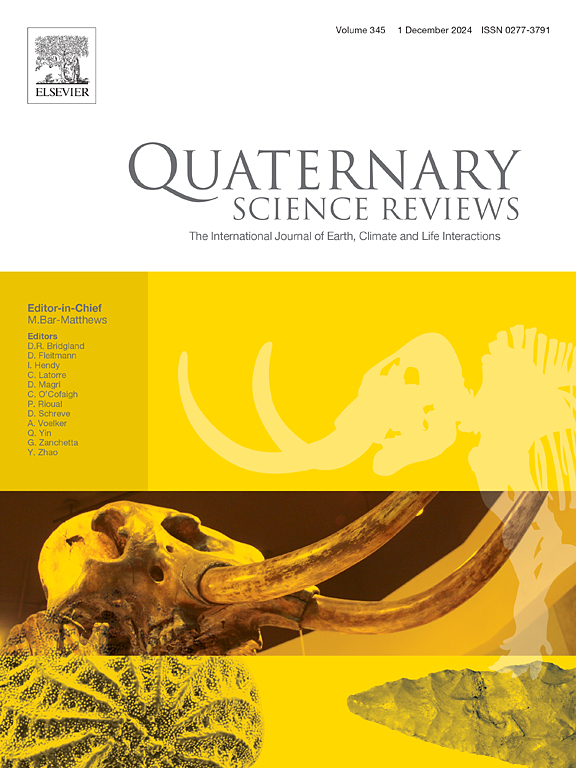晚全新世亚马逊西部湖泊周围的多相利用和占领
IF 3.3
1区 地球科学
Q1 GEOGRAPHY, PHYSICAL
引用次数: 0
摘要
关于过去2000年洪水事件、干旱和人类活动对亚马逊西北部植被形成的相对重要性,存在着相互竞争的假设。我们假设干燥的环境更有利于人类在这些潮湿的森林中居住,我们提供了一个高分辨率的多代理古生态记录,这些记录来自厄瓜多尔西北部一个目前无人居住的湖泊,Zancudococha。分析了花粉、植物岩、木炭、XRF和着火损失数据,重建了气候变化和人类活动对当地植被形成的相对作用。在我们的研究开始时,人类可能已经在影响这个系统了。通过使用花粉百分比模拟过去森林覆盖的变化,我们发现土地利用强度在公元470年至1360年间最高。总的来说,在过去的2000年里,干燥的环境比潮湿的环境更有可能支持玉米的种植,这在中世纪气候异常时期(约公元900-1250年)尤为明显。在公元1360年至1630年之间出现了一个废弃阶段,当时所有人类活动的迹象都从记录中消失了,森林覆盖面积增加了。该湖后来被重新占领,在耶稣会(公元1680-1890年)和橡胶繁荣(公元1890-1925年)时期有小规模的清理,接近现代的废弃发生在公元1925年左右。本文章由计算机程序翻译,如有差异,请以英文原文为准。
Late Holocene multiphasic use and occupation around a western Amazonian Lake
Competing hypotheses exist regarding the relative importance of flood events, droughts, and human activity in shaping northwest Amazonian vegetation within the last 2000 years. We hypothesize that drier conditions were more favorable for human occupation in these ever-wet forests, and we present a high-resolution multiproxy paleoecological record of the last two millennia from a currently uninhabited lake, Zancudococha, in northwestern Ecuador. Pollen, phytoliths, charcoal, XRF, and loss-on-ignition data were analyzed to reconstruct the relative roles of climatic changes and human activity in shaping local vegetation. Humans were probably already influencing this system at the onset of our study period. By modeling past forest cover changes using pollen percentages, we showed that land-use intensity was highest between c. 470 and 1360 CE. Overall, drier conditions were more likely to have supported maize cultivation over the last 2000 years than wet ones, and this was especially clear during the Medieval Climate Anomaly (c. 900–1250 CE). An abandonment phase occurred between 1360 and c. 1630 CE, when all signs of human activity disappeared from the record and forest cover increased. The lake was later reoccupied, and there were small-scale clearances during the Jesuit (1680–1890 CE) and Rubber Boom (1890–1925 CE) times, with near modern abandonment occurring c. 1925 CE.
求助全文
通过发布文献求助,成功后即可免费获取论文全文。
去求助
来源期刊

Quaternary Science Reviews
地学-地球科学综合
CiteScore
7.50
自引率
15.00%
发文量
388
审稿时长
3 months
期刊介绍:
Quaternary Science Reviews caters for all aspects of Quaternary science, and includes, for example, geology, geomorphology, geography, archaeology, soil science, palaeobotany, palaeontology, palaeoclimatology and the full range of applicable dating methods. The dividing line between what constitutes the review paper and one which contains new original data is not easy to establish, so QSR also publishes papers with new data especially if these perform a review function. All the Quaternary sciences are changing rapidly and subject to re-evaluation as the pace of discovery quickens; thus the diverse but comprehensive role of Quaternary Science Reviews keeps readers abreast of the wider issues relating to new developments in the field.
 求助内容:
求助内容: 应助结果提醒方式:
应助结果提醒方式:


